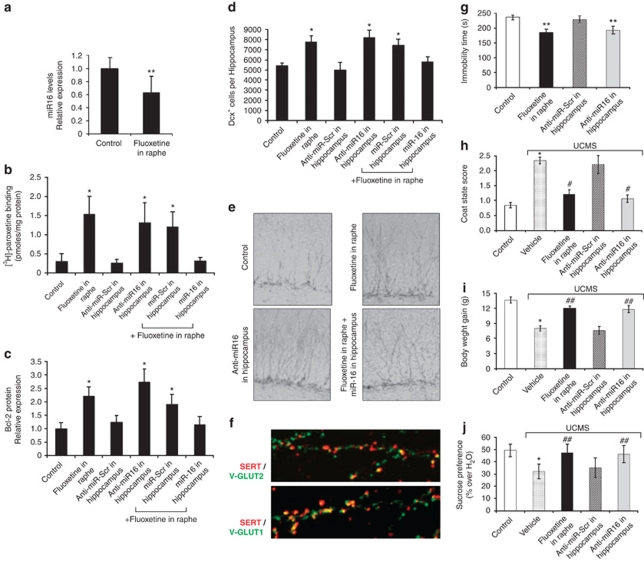Figure 1.
Infusion of fluoxetine into raphe decreases miR-16 in the hippocampus, which in turn, increases serotonin transporter (SERT) and bcl-2 levels, promotes neurogenesis and exerts an antidepressant effect. (a–e) Mice received a chronic perfusion of fluoxetine into raphe (1 μ, 2 μl min−1, 3 days) in combination (n=11) or not (n=6) with direct injection of miR-16 (1 μl, 2 μ, every 36 h) into the hippocampus. Alternatively, a direct injection of anti-miR-16 (1 μl, 2 μ, every 36 h, n=6 mice) alone into the hippocampus was performed. Scrambled miRNAs (n=7) or anti-miRNAs (n=10) were used as controls. Control values were obtained in n=13 mice. All measurements were made on hippocampus samples: miR-16 level (real-time PCR) (a), SERT expression ([3H]-paroxetine binding) (b), Bcl-2 protein expression (western blot) (c) and neurogenesis (Doublecortin (Dcx) immunolabeling) (d, e). (f) Immunolabeling of SERT (red) in hippocampal cells positive for V-GLUT 1 (bottom) or V-GLUT-2 (top) (green) after infusion of fluoxetine into raphe for 3 days. (g) Injection of fluoxetine into raphe or anti-miR16 into the hippocampus similarly reduced the time of immobility in the forced swimming test. (h–j) Six-week unpredictable chronic mild stress (UCMS)-induced deterioration of the coat state score (h) and reductions in body weight gain (i) and sucrose preference (j) were alleviated by injection of fluoxetine into raphe or anti-miR16 into the hippocampus (n=9 mice in each group). Values are means±s.e.m. *P<0.01 and **P<0.05 vs control, #P<0.01 and ##P<0.05 vs vehicle UCMS.

